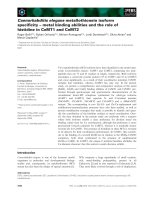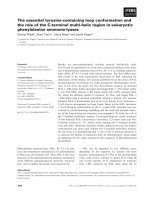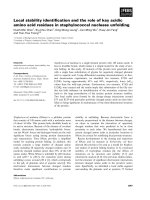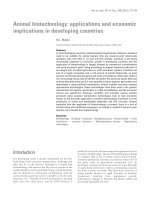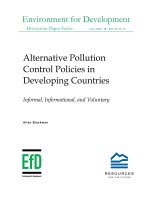Economic Preferences In Developing Countries: Intergenerational Transmission And The Role Of Cognitive Ability
Bạn đang xem bản rút gọn của tài liệu. Xem và tải ngay bản đầy đủ của tài liệu tại đây (91.4 KB, 6 trang )
<span class='text_page_counter'>(1)</span><div class='page_container' data-page=1>
<b>ECONOMIC PREFERENCES IN DEVELOPING COUNTRIES: </b>
<b>INTERGENERATIONAL TRANSMISSION AND THE ROLE OF COGNITIVE </b>
<b>ABILITY </b>
Yanjun Li Anh Nguyet Tran T.
Abstrac
</div>
<span class='text_page_counter'>(2)</span><div class='page_container' data-page=2>
smoking and child marriage, as well as career choices (self-employment)
are particularly crucial issues in Indonesia.
Keywords. Risk preferences; Trust; Intergenerational transmission;
Cultural eco- nomics; Family economics; Assortative mating; Social
interactions; IFLS; Development economics. JEL classification. D1, D8,
J12, J13, J62, O12, Z13.
Extended Abstract
1 Introduction and motivation
Preferences, beliefs, and attitudes that guide personal behaviors are partially formed
based on heritable genetic factors, and partially passed across generations by social
learn- ing (Bisin and Verdier, 2010); parents are deeply involved throughout the
whole process. Preferences transmitted from parents to their offspring may include
many fundamental ones, such as risk or time preferences. These two dimensions of
individual preferences have been empirically shown to have a significant impact on
a wide range of essential choices and behaviors, including personal habits ( ubi cka
et al., 2001), educational attainment (Castillo et al., 2011; Golsteyn et al., 2014),
occupation and labor market outcomes (Heck- man et al., 2006; Deming, 2017),
financial behavior (Agarwal and Mazumder 2013; Lusardi and Mitchell 2014), etc.,
and thus are of great value to researchers and policymakers.
</div>
<span class='text_page_counter'>(3)</span><div class='page_container' data-page=3>
However, as our results demonstrate below, the intergenerational transmission of
risk attitudes and impatience in the setting of a developing country leads to several
interesting and meaningful implications. We provide evidence on three distinct
aspects of the preference transmission process. First, we analyse the preferences
transmission from parents to children using direct mea- sures of risk and time
preferences for individuals and their parents. Second, we test for another aspect of
the transmission process through assortative matching of parental prefer- ences.
Within this framework, we strengthen the findings by controlling for fixed effects of
local environment on individual?s preferences. The theoretical models by Bisin and
Verdier (2000) and Bisin et al. (2004) predict that spouses may engage in strategic,
assortative matching in order to more efficiently transmit their preferences/attitudes
to offspring.
Finally, we address a recent question on the relationship between cognitive ability
and economic preferences: whether risk and time preferences are related to
individual cognitive skills in the context of developing countries. As before, from
our best knowledge, this is the first study on the preference transmission while
simultaneously investigating the cognition-preference gradient in a developing
country.
2 Results
</div>
<span class='text_page_counter'>(4)</span><div class='page_container' data-page=4>
for further individual characteristics (gender, age, and cognitive ability). A second
finding is that, the magnitude of parents-child preference transmission lowers by
almost by a half once we control for the fixed effects of residential communities.
This is true for both time and risk preferences and over time (in 2007 and in 2014).
These results suggest that local environment (and therefore, average preferences at
the local level) play a role in shaping individual preferences, apart from parental
effects.
The third main finding is a strong pattern of positive correlation of risk and time
preferences among spouses (i.e., parents of the respondents), consistent with the
theoretical models on assortative matching. We find a comparably large correlation
between spouses’ preferences, again qualitatively unchanged over a period of seven
years. Combined with the previous findings that both mother’s and father’s
preferences are transmitted to children, this result of assortative matching strongly is
highly consistent with the implications of attitude transmission theories.
Finally, as we already emphasize, our study also speaks to the relationship between
cognitive ability and risk preference and impatience in the context of developing
countries. Our results suggest that both risk and time preferences vary systematically
with cognitive ability, conditional on parental transmission of preferences, local
environment, as well as individual characteristics. For example, in 2007, 50 percent
increase in cognitive ability are associated with 7.5 percent increase in individual’s
willingness to take risks, and 10 percent increase in patience over the yearlong time
horizon. More remarkably, we obtain qualitatively similar results on the
preferences-cognition gradient of the same sample of individuals after 7 years.
3 Data description: the Indonesian Family Life Survey 1997-
2015
</div>
<span class='text_page_counter'>(5)</span><div class='page_container' data-page=5>
survey, and contains information on risk and time preferences of the respondents
and their parents, and individual’s cognitive ability as well as other demographic
backgrounds.
3.1 Individual risk and time preferences
In these waves, the study administered a series of questions to elicit attitudes towards
risk and time preference on all individuals aged 15 and older. We use the
information from these modules to construct the measures for respondents and their
parents in 2007 and 2015.<sub>Both measures of risk preferences consist of a series of eight interdependent hypothetical </sub>
binary choices between lotteries and safe financial rewards. The first four pairs of
lotteries give a higher expected payment for the riskier choice, whereas the latter
four pairs of lotteries give a higher expected payment for the safer choice. We took
the number of risky decisions the respondents made as the measure of individual
risk attitudes (Holt and Laury, 2002; Lonnqvist et al., 2015; Dohmen et al., 2018).
The measure of time preferences is similarly derived from eight hypothetical binary
choices between immediate and delayed payment in a “staircase” procedures
(Cornsweet, 1962; Dohmen et al., 2018). In each of eight questions, participants,
respondents decide between receiving a reward today or larger payments in one year
and then in five years. We took the number of delayed choices as the measure of
individual’s patience (Dohmen et al., 2018).
3.2 Explanatory variable: cognitive ability
</div>
<span class='text_page_counter'>(6)</span><div class='page_container' data-page=6>
I use the test scores as manifestation measures of the unobserved fluid intelligence.
The unobserved cognitive factor is recovered using a measurement system widely
used in the psychology and the economics literature on human capital development
(for example, Bollen, 1989; Cunha and Heckman, 2008; Cunha et al., 2010;
Agostinelli and Wiswall, 2018).
4 Tables and graphs
Child’s risk and time preferences as a linear function of parents’ preferences using
the IFLS4 data in 2007. The graphs on the upper panel show children’s average
scores of risky choices (standardized), i.e., willingness to take risks for a given level
of willingness to take risks of fathers (right graph) and of mothers (left graph). The
lower graphs show children’s average scores of delayed rewards (standardized), i.e.,
patience, for a given level of father’s patience (left graph) and mother’s patience
(right graph).
</div>
<!--links-->





